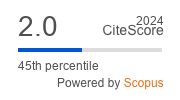Contrasting information disorder by leveraging people’s biases and pains: innovating in the post-truth era
DOI:
https://doi.org/10.23726/cij.2021.1053Keywords:
Fake news, internet, social media, disinformation, misinformation, design thinkingAbstract
Disinformation and misinformation have been around since the advent of the media. Many solutions have been developed to contrast this phenomenon such as automated fact-checking tools, media literacy programs, or content moderation strategies. However, these endeavours are limited in scope and easily succumb to the ever changing online information landscape. In addition to that, the human brain is extremely susceptible to fake contents due to frequent biases and illusory effects. On this basis, the present paper describes the application of slightly readapted design thinking methodologies in tackling information disorder as an unconventional approach to global challenges.References
AfricaCheck, Chequeado, Full Fact, 2020, Who is most likely to believe and to share misinformation? https://fullfact.org/media/uploads/who-believes-shares- misinformation.pdf
Allen J. et al., 2020, Evaluating the fake news problem at the scale of the information ecosystem, Science Advances, 6(14): aay3539. https://doi.org/10.1126/sciadv.aay3539
Boyd D., 2018, You Think You Want Media Literacy...Do You? Medium, https://points.datasociety.net/you-think- you-want-media-literacy-do-you-7cad6af18ec2; (accessed 30/05/2020).
Bowman N.D. and Cohen E., 2020, Mental Shortcuts, Emotions, and Social Rewards: The Challenge of Detecting and Resisting Fake News, in Fake News: Understanding Media and Misinformation in the Digital Age (Information Policy), The MIT Press, Boston, USA.
Carlgren L. et al., 2016, The Challenges of Using Design Thinking in Industry – Experiences from Five Large Firms, Creativity and Innovation Management, 25(3): pp. 344-362.
Check J., Schutt R.K., 2012, Survey research. In: J. Check, R. K. Schutt., editors. Research methods in education. Thousand Oaks, Sage Publications, London, UK, pp. 159– 185.
Donohue A., 2019, Using artificial intelligence to expand fact- checking, Reporters’ LAB, https://reporterslab.org/using- artificial-intelligence-to-expand-fact-checking/, (accessed 20/5/2020).
Ireton C. et al., 2018, Journalism, "Fake News" & Disinformation, Handbook for Journalism Education and Training, UNESCO Series on Journalism Education, UNESCO, France, https://en.unesco.org/fightfakenews
Koltay T. et al., 2016, The Nature of Information Literacy, in Research 2.0 and the Future of Information Literacy. Chandos Publishing.
Moulding R. et al., 2016, Better the devil you know than a world you don't? Intolerance of uncertainty and worldview explanations for belief in conspiracy theories, Personality and Individual Differences, 98: pp. 345-354,
https://doi.org/10.1016/j.paid.2016.04.060
Nakata C., Hwang J., 2020, Design thinking for innovation: Composition, consequence, and contingency, Journal of Business Research, 118: pp. 117-128.
Newton C., 2016, Facebook partners with fact-checking organizations to begin flagging fake news, The Verge, https://www.theverge.com/2016/12/15/13960062/faceboo k-fact-check-partnerships-fake-news; (accessed 20/05/2020).
Phillips W., 2020, You're Fake News: The Problem with Accusations of Falsehood, in Fake News: Understanding Media and Misinformation in the Digital Age (Information Policy), The MIT Press, Boston, USA.
Polage D., 2020, Source Credibility and Belief in Fake News: I'll Believe You if You Agree with Me, in Fake News: Understanding Media and Misinformation in the Digital Age (Information Policy), The MIT Press, Boston, USA.
Ponto J., 2015, Understanding and Evaluating Survey Research, Journal of the Advanced Practitioner in Oncology, 6(2): 168-171.
Sunstein C.R., 2008, The Architecture of Serendipity, The Harvard Crimson. https://www.thecrimson.com/article/2008/6/4/the- architecture-of-serendipity-this-years/
Todd P.M., 2001, Heuristics for Decision and Choice, International Encyclopedia of the Social & Behavioral Sciences, Pergamon, pp. 6676-6679.
Waddell K., 2016, Facebook and Google Won’t Let Fake News Sites Use Their Ad Networks, The Atlantic. https://www.theatlantic.com/technology/archive/2016/11/f acebook-and-google-wont-let-fake-news-sites-use-their- ads-platforms/507737/ (accessed 20/05/2020).
Westneat D., 2017, The information war is real, and we’re losing it, The Seattle Times, https://www.seattletimes.com/seattle-news/politics/uw- professor-the-information-war-is-real-and-were-losing-it/; (accessed 20/05/2020).
Zizek S., 1999, The Ticklish Subject, Verso, London, UK.
Downloads
Published
How to Cite
License
Copyright (c) 2021 Paolo Pino, Nasim Fallahi, Davide Buccheri, Emanuele Alberti, Samuel Salini, Alessandro Bettuzzi, Giacomo Luddeni

This work is licensed under a Creative Commons Attribution 4.0 International License.
Authors who publish with this journal agree to the following terms:
- Authors retain copyright and grant the journal right of first publication with the work simultaneously licensed under a Creative Commons Attribution License that allows others to share the work with an acknowledgement of the work's authorship and initial publication in this journal.
- Authors are able to enter into separate, additional contractual arrangements for the non-exclusive distribution of the journal's published version of the work (e.g., post it to an institutional repository or publish it in a book), with an acknowledgement of its initial publication in this journal.
- Authors are permitted and encouraged to post their work online (e.g., in institutional repositories or on their website) prior to and during the submission process, as it can lead to productive exchanges, as well as earlier and greater citation of published work (See The Effect of Open Access).


